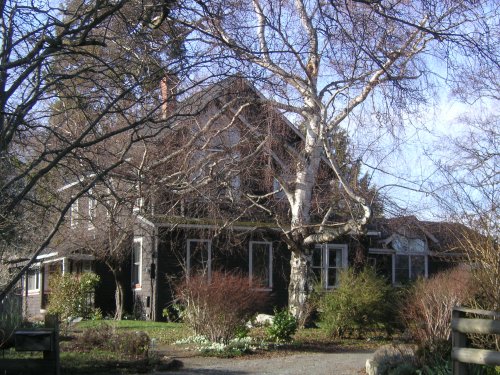2072 Hampshire Road


This vernacular farmhouse is well setback on property at junction of Hampshire, Musgrave and Cavendish Roads on land that extends from Hampshire to Cadboro Bay Road. The front garden was once an orchard and some fruit trees remain; at the rear, facing Cadboro Bay Road, is a wooded area of native plants.
This site is a rare example of an early rural farmhouse built in the early 1880s. At the core of the present building, is a farmhouse, built in the 1880s, that is one of two homes surviving from the early years of European settlement. By 1858 all the land in what is now Oak Bay was owned by four employees of the Hudson's Bay Company (HBC) and the Company itself. This half-acre (0.2 ha.) site was once part of the 406 acres of arable land purchased in 1851 by John Tod, a Chief Factor with the Hudson's Bay Company. According to local knowledge, upon the marriage of his daughter Mary to John Sylvester Bowker, in 1864, Tod gave the couple this land on which stood a hut used by migrant fruit pickers. The hut, the existence of which is apparent in the interior of the present house, has been augmented over the years to serve as a family home. John Tod’s house, 'Oak Bay House' at 2564 Heron Street, is believed to be one of the oldest houses in western Canada.
This site is important as a reminder of the agricultural past of Oak Bay, particularly in its rural setting in the midst of an urban environment; and the house demonstrates the evolution of a building to accommodate the changing needs of growing families whilst maintaining the original portion of the initial 1880s building. In the late 1880s or early 90s it seems likely a larger lean-to addition was added to the rear of the main building; a fireplace hood, hinges, and other hardware are consistent with that era. Later, shingles were applied over the original narrow drop siding; and in the 1930s another addition extended past the kitchen and included a glazed sun porch. The house has had subsequent renovations.
This site is of significance for its association with the Tod family, John Sylvester Bowker, Alfred Dixon Fuller, and its current owner, George Corwin. John Tod was a Scottish-born HBC fur trader and Chief factor that purchased 406 acres of fields and oaks south of Uplands Farm between what is now Cadboro Bay Road and Willows Beach/Cattle Point area. Tod was one of five original landholders in Oak Bay, the first Company retiree to settle in the area, and a member of the Council of the Colony of Vancouver Island, appointed in 1850 by Governor Richard Blanshard. The name Bowker is remember in Bowker Creek which ran alongside the farm, and in Bowker Road, just south of this site; the Creek is now buried in conduits for over fifty percent of its length, but the remainder is an important community amenity and is managed under the Bowker Creek Watershed Management Plan. Alfred Dixon Fuller purchased the land from the Bowkers in 1884, and is remembered for subdividing the property. The current owner is the internationally-recognized musician, George Corwin who was Professor of Music at the University of Victoria from 1969 to 1995.
- site/setting/views to Willows Beach along Cavendish Road
- location on large property that extends from Cadboro Bay Road to Musgrave Avenue
- form, scale and massing
- wood frame construction, shingle cladding
- style details such as window horns
- exterior architectural elements such as: three internal chimneys with corbelled brick chimney-stacks, original doors
- fenestration, and window types such as: double-hung sashes; single sash; awning
- interior features such as: original woodwork including wainscotting; original light fixtures; original window hardware
- landscape features: mature coniferous and deciduous trees-particularly two American beech and a Paper Birch, many mature Horse Chestnuts, Robinia, Arbutus, Elms; former front gate at Cadboro Bay Road entrance
 Instagram
Instagram
 Facebook
Facebook
 Twitter
Follow @DistrictOakBay
Twitter
Follow @DistrictOakBay